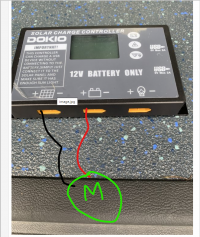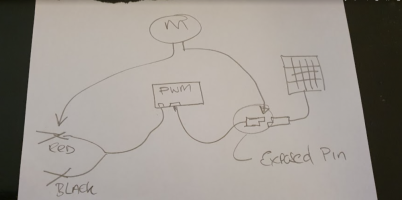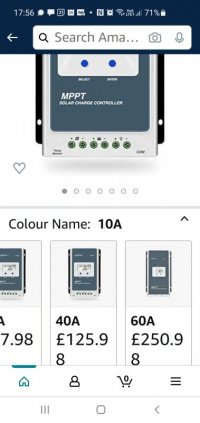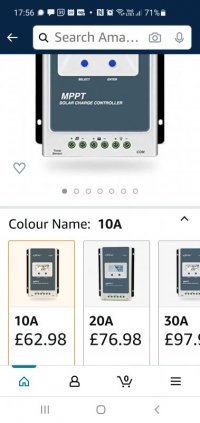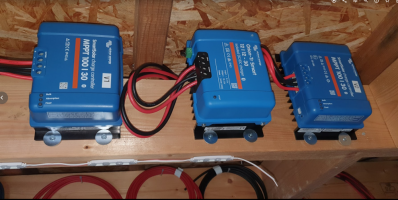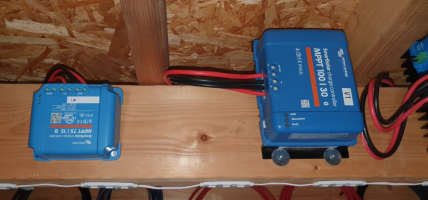You are using an out of date browser. It may not display this or other websites correctly.
You should upgrade or use an alternative browser.
You should upgrade or use an alternative browser.
then try to bell out the end exposed PIN on the PV side cable back to the same POS pin on the controller.
to show you that the POS is direct to the panel.
and therefore live.
+++
to show you that the POS is direct to the panel.
and therefore live.
+++
Confirmed !
So basically it’s a disaster waiting to happen and no mention of this rather important data in any of the information that comes with the kit.
I had no idea of this, until it was almost fatal.
a direct live positive connection to the leisure battery to an exposed terminal … wow
The only safety info supplied was to always connect the battery first ! In order not to damage the controller .
So basically it’s a disaster waiting to happen and no mention of this rather important data in any of the information that comes with the kit.
I had no idea of this, until it was almost fatal.
a direct live positive connection to the leisure battery to an exposed terminal … wow
The only safety info supplied was to always connect the battery first ! In order not to damage the controller .
Last edited:
Yep . . . thought so.
if the RED crock clip was fused then it would have blown and protected the cable from the short.
if the RED crock clip was fused then it would have blown and protected the cable from the short.
This has really made me question the received wisdom that you don’t need to fuse the controller-panel cabling.
The solar panel can’t generate enough current to cause an issue but in this case the panel side cabling has somehow gone ‘live’ direct from the battery? Could this potentially happen with a good quality MPPT controller too? I guess given the battery-controller is always be fused which gives protection from the battery side itself maybe this is sufficient protection?
This is a standard configuration for PWM solar controllers.
They work by connecting the POS from the panel directly to the POS of the battery.
But the black NEG is used as the switch . . . internally in the PWM controller.
The controller watches the PV voltage, as soon as it get about 3-5v above the battery voltage it closes the internal switch so current can flow,
it does the open/close switch thing multiple times per second. . . . in pulses, and adjusts the length of the pulse as needed.
longer pulses for more charge, shorter pulses for less...
That where the PWM comes from = Pulse Width Modulation
its unfortunate that, that particular DOKIO kit has 2x design issues,
1- the RED battery connection is un-fused. (no safety disconnect)
2- The PV connection is uninsulated ( possible short circuit if used in a vehicle)
+++
MPPT controller work very different. . .
they have a proper charger circuit and will not power up without seeing the battery and testing the PV etc first.
+++
Just remember to fuse all battery connections.
+++
Though driving around with a couple of battery clamps clipped to the Leisure battery under the drivers seat is probably not the best idea . . .
The setup should be fail safe and be able to protect against the user and or a fault. ( ie fused RED battery connection at a min )
.
FWIW:
if Dokio had used standard MC4 connections (instead of that SAE connector) of the PV side this may not have happened as the MC4 connectors are better insulated with no exposed PINS.
if Dokio had used standard MC4 connections (instead of that SAE connector) of the PV side this may not have happened as the MC4 connectors are better insulated with no exposed PINS.
... and rated to 400vFWIW:
if Dokio had used standard MC4 connections (instead of that SAE connector) of the PV side this may not have happened as the MC4 connectors are better insulated with no exposed PINS.
This is a standard configuration for PWM solar controllers.
They work by connecting the POS from the panel directly to the POS of the battery.
But the black NEG is used as the switch . . . internally in the PWM controller.
The controller watches the PV voltage, as soon as it get about 3-5v above the battery voltage it closes the internal switch so current can flow,
it does the open/close switch thing multiple times per second. . . . in pulses, and adjusts the length of the pulse as needed.
longer pulses for more charge, shorter pulses for less...
That where the PWM comes from = Pulse Width Modulation
its unfortunate that, that particular DOKIO kit has 2x design issues,
1- the RED battery connection is un-fused. (no safety disconnect)
2- The PV connection is uninsulated ( possible short circuit if used in a vehicle)
+++
MPPT controller work very different. . .
they have a proper charger circuit and will not power up without seeing the battery and testing the PV etc first.
+++
Just remember to fuse all battery connections.
+++
Though driving around with a couple of battery clamps clipped to the Leisure battery under the drivers seat is probably not the best idea . . .
The setup should be fail safe and be able to protect against the user and or a fault. ( ie fused RED battery connection at a min )
.
EPEVER MPPT Solar Charge Controller Tracer AN Series 10A/20A/30A/40A with 12V/24V DC Automatically Identifying System Voltage(10A) : Amazon.co.uk: Business, Industry & Science
EPEVER MPPT Solar Charge Controller Tracer AN Series 10A/20A/30A/40A with 12V/24V DC Automatically Identifying System Voltage(10A) : Amazon.co.uk: Business, Industry & Science
www.amazon.co.uk
@osman yes you could use the EPEVER. - its fairly bulky tho . .
i prefer the Victron kit - its top notch. (and comes with an APP if you get the Bluetooth version)
for that panel have a look at the 75/15.
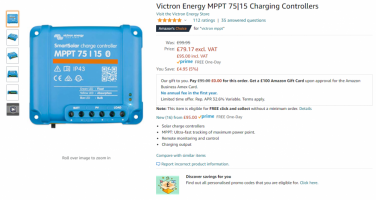
i prefer the Victron kit - its top notch. (and comes with an APP if you get the Bluetooth version)
for that panel have a look at the 75/15.
Victron Energy MPPT 75|15 Charging Controllers : Amazon.co.uk: Automotive
Buy Victron Energy MPPT 75|15 Charging Controllers at Amazon UK. Free delivery on eligible orders.
amzn.to

id also look at swapping the Panel SAE connector for standard MC4 connectors.
this is the SAE:
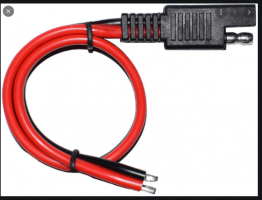
+++
this is MC4 connectors . .
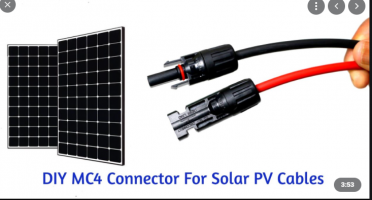
++++++++++++++++++
more info here:

 www.t6forum.com
www.t6forum.com
.

.
this is the SAE:

+++
this is MC4 connectors . .

++++++++++++++++++
more info here:

[Guide] Solar Cables? . . . - How I Did It -
[Guide] Solar Cables? . . . - How I Did It - its time for another guide . . . This time on solar cables. we use these cables for permanent install and for mobile installs. lets start with the Solar PV MC4-MC4 cable. Solar PV cable is not actually standard cable . . . its more specialised...
.

.
So is this 20 amp ? It’s hard to find any tech info on the Amazon advert@osman yes you could use the EPEVER. - its fairly bulky tho . .
i prefer the Victron kit - its top notch. (and comes with an APP if you get the Bluetooth version)
for that panel have a look at the 75/15.
Victron Energy MPPT 75|15 Charging Controllers : Amazon.co.uk: Automotive
Buy Victron Energy MPPT 75|15 Charging Controllers at Amazon UK. Free delivery on eligible orders.amzn.to
View attachment 121632
I meant the one you recommended the victron . It’s just that the current controller is 20amp so I presume that’s what I need. But my panel is 300w and I’ve just checked the 20 amp victron says suitable up to 290w ..I guess that’s probably fine but don’t want any more melting wires and near death experiencesWhich.....?
The Epever?... those are availible in 10A - 60A versions..
The Victron shown above is 15A. (75v/15a).
.
View attachment 121649View attachment 121650
Last edited:
I read ‘POS’ as ‘piece of $***’ rather than ‘positive!’have you got a multimeter?
if you have test the resistance or continuity between these two pins.
if the meter shows 0,0ohms that implys that its a common POS PWM controller.
View attachment 121613

Me too.I read ‘POS’ as ‘piece of $***’ rather than ‘positive!’
I meant the one you recommended the victron . It’s just that the current controller is 20amp so I presume that’s what I need
The Amazon seller is trying to tell me the controller is fused there is no design issue and I must have connected the solar panel directly to the battery to cause the cable to burn ! lol the cables provided would not allow that connection even if I was stupid enough .Yep . . . thought so.
if the RED crock clip was fused then it would have blown and protected the cable from the short.
So now it’s a matter of proving to Amazon that the positive connection is common not switched and unfused .. which we basically did using the multi meter .
Great thread and info as always @Dellmassive
Having just taken delivery of
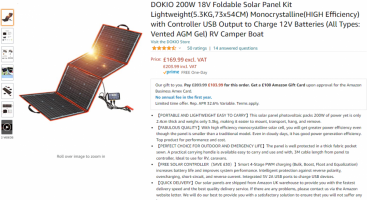
I am reading this with much interest/fear!
My leisure battery is in a cubby hole at the rear of the van with the split charger etc mounted in a cupboard above it.
The plan was to leave the cables connected to the battery and Dokio controller which will be fixed to the side of the van.
Obviously I need to introduce a fuse into the live cable (what size would you suggest) before it reaches the controller.
I hoped then to leave the extension cable curled up in the cupboard, maybe now I should leave it disconnected to be sure but having purchased
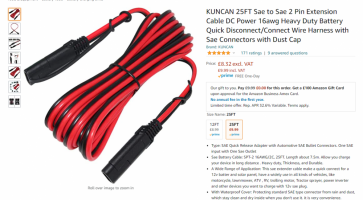
This cable has a rubber cap on the end and not only that wont be rolling around and merely routed out of the van and connected to the solar panel as and when we are using it.
Doubtless eventually we will end up having to replace the controller OR go for a roof top fixed system UNTIL then, have we a safe set up would you say?
Having just taken delivery of
DOKIO 200W 18V Foldable Solar Panel Kit Lightweight(5.3KG,73x54CM) Monocrystalline(HIGH Efficiency) with Controller USB Output to Charge 12V Batteries (All Types: Vented AGM Gel) RV Camper Boat
edit: . .
DOKIO 200W 18V Foldable Solar Panel Kit Lightweight(5.3KG,73x54CM) Monocrystalline(HIGH Efficiency) with Controller USB Output to Charge 12V Batteries (All Types: Vented AGM Gel) RV Camper Boat : Amazon.co.uk: Business, Industry & Science
DOKIO 200W 18V Foldable Solar Panel Kit Lightweight(5.3KG,73x54CM) Monocrystalline(HIGH Efficiency) with Controller USB Output to Charge 12V Batteries (All Types: Vented AGM Gel) RV Camper Boat : Amazon.co.uk: Business, Industry & Science
amzn.to
DOKIO 200W 18V Foldable Solar Panel Kit Lightweight(5.3KG,73x54CM) Monocrystalline(HIGH Efficiency) with Controller USB Output to Charge 12V Batteries (All Types: Vented AGM Gel) RV Camper Boat : Amazon.co.uk: Business, Industry & Science
DOKIO 200W 18V Foldable Solar Panel Kit Lightweight(5.3KG,73x54CM) Monocrystalline(HIGH Efficiency) with Controller USB Output to Charge 12V Batteries (All Types: Vented AGM Gel) RV Camper Boat : Amazon.co.uk: Business, Industry & Science
amzn.to

I am reading this with much interest/fear!
My leisure battery is in a cubby hole at the rear of the van with the split charger etc mounted in a cupboard above it.
The plan was to leave the cables connected to the battery and Dokio controller which will be fixed to the side of the van.
Obviously I need to introduce a fuse into the live cable (what size would you suggest) before it reaches the controller.
I hoped then to leave the extension cable curled up in the cupboard, maybe now I should leave it disconnected to be sure but having purchased
KUNCAN 25FT Sae to Sae 2 Pin Extension Cable DC Power 16awg Heavy Duty Battery Quick Disconnect/Connect Wire Harness with Sae Connectors with Dust Cap
KUNCAN 25FT Sae to Sae 2 Pin Extension Cable DC Power 16awg Heavy Duty Battery Quick Disconnect/Connect Wire Harness with Sae Connectors with Dust Cap : Amazon.co.uk: Automotive
Buy KUNCAN 25FT Sae to Sae 2 Pin Extension Cable DC Power 16awg Heavy Duty Battery Quick Disconnect/Connect Wire Harness with Sae Connectors with Dust Cap at Amazon UK. Free delivery on eligible orders.
amzn.to

This cable has a rubber cap on the end and not only that wont be rolling around and merely routed out of the van and connected to the solar panel as and when we are using it.
Doubtless eventually we will end up having to replace the controller OR go for a roof top fixed system UNTIL then, have we a safe set up would you say?
Last edited by a moderator:
Similar threads
- Replies
- 8
- Views
- 368
- Replies
- 44
- Views
- 2K
- Replies
- 4
- Views
- 1K

